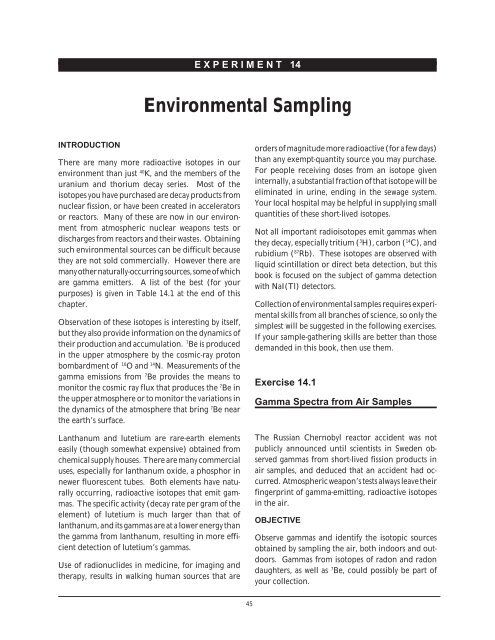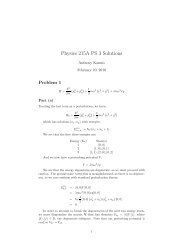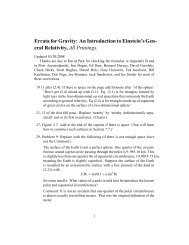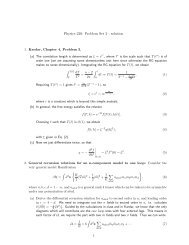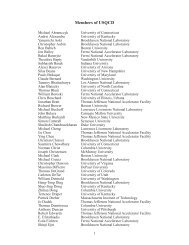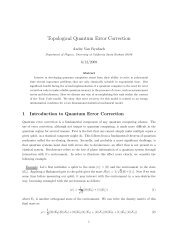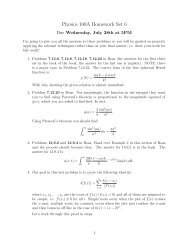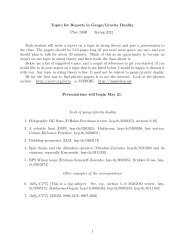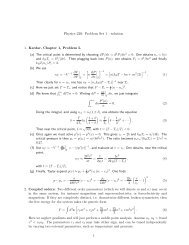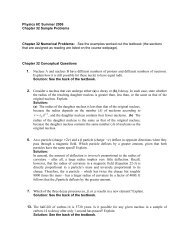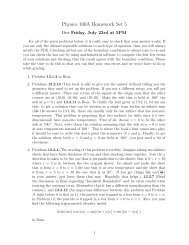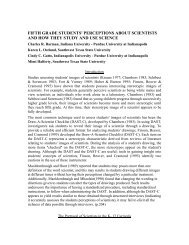Nuclear Spectroscopy
Nuclear Spectroscopy
Nuclear Spectroscopy
Create successful ePaper yourself
Turn your PDF publications into a flip-book with our unique Google optimized e-Paper software.
E X P E R I M E N T 14<br />
Environmental Sampling<br />
INTRODUCTION<br />
There are many more radioactive isotopes in our<br />
environment than just 40 K, and the members of the<br />
uranium and thorium decay series. Most of the<br />
isotopes you have purchased are decay products from<br />
nuclear fission, or have been created in accelerators<br />
or reactors. Many of these are now in our environment<br />
from atmospheric nuclear weapons tests or<br />
discharges from reactors and their wastes. Obtaining<br />
such environmental sources can be difficult because<br />
they are not sold commercially. However there are<br />
many other naturally-occurring sources, some of which<br />
are gamma emitters. A list of the best (for your<br />
purposes) is given in Table 14.1 at the end of this<br />
chapter.<br />
Observation of these isotopes is interesting by itself,<br />
but they also provide information on the dynamics of<br />
their production and accumulation. 7 Be is produced<br />
in the upper atmosphere by the cosmic-ray proton<br />
bombardment of 16 O and 14 N. Measurements of the<br />
gamma emissions from 7 Be provides the means to<br />
monitor the cosmic ray flux that produces the 7 Be in<br />
the upper atmosphere or to monitor the variations in<br />
the dynamics of the atmosphere that bring 7 Be near<br />
the earth’s surface.<br />
Lanthanum and lutetium are rare-earth elements<br />
easily (though somewhat expensive) obtained from<br />
chemical supply houses. There are many commercial<br />
uses, especially for lanthanum oxide, a phosphor in<br />
newer fluorescent tubes. Both elements have naturally<br />
occurring, radioactive isotopes that emit gammas.<br />
The specific activity (decay rate per gram of the<br />
element) of lutetium is much larger than that of<br />
lanthanum, and its gammas are at a lower energy than<br />
the gamma from lanthanum, resulting in more efficient<br />
detection of lutetium’s gammas.<br />
Use of radionuclides in medicine, for imaging and<br />
therapy, results in walking human sources that are<br />
orders of magnitude more radioactive (for a few days)<br />
than any exempt-quantity source you may purchase.<br />
For people receiving doses from an isotope given<br />
internally, a substantial fraction of that isotope will be<br />
eliminated in urine, ending in the sewage system.<br />
Your local hospital may be helpful in supplying small<br />
quantities of these short-lived isotopes.<br />
Not all important radioisotopes emit gammas when<br />
they decay, especially tritium ( 3 H), carbon ( 14 C), and<br />
rubidium ( 87 Rb). These isotopes are observed with<br />
liquid scintillation or direct beta detection, but this<br />
book is focused on the subject of gamma detection<br />
with NaI(Tl) detectors.<br />
Collection of environmental samples requires experimental<br />
skills from all branches of science, so only the<br />
simplest will be suggested in the following exercises.<br />
If your sample-gathering skills are better than those<br />
demanded in this book, then use them.<br />
Exercise 14.1<br />
Gamma Spectra from Air Samples<br />
The Russian Chernobyl reactor accident was not<br />
publicly announced until scientists in Sweden observed<br />
gammas from short-lived fission products in<br />
air samples, and deduced that an accident had occurred.<br />
Atmospheric weapon’s tests always leave their<br />
fingerprint of gamma-emitting, radioactive isotopes<br />
in the air.<br />
OBJECTIVE<br />
Observe gammas and identify the isotopic sources<br />
obtained by sampling the air, both indoors and outdoors.<br />
Gammas from isotopes of radon and radon<br />
daughters, as well as 7 Be, could possibly be part of<br />
your collection.<br />
45


